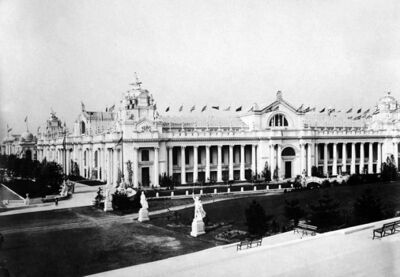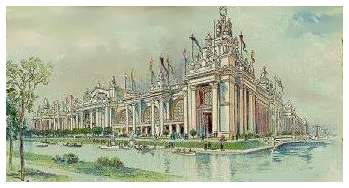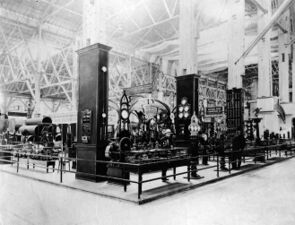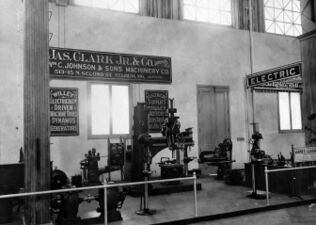Palace of Electricity
 | |
| Location | Main Picture |
|---|---|
| No. of Buildings | 1 |
| Construction | |
| Construction Cost | $412,948 ($12.5 million in 2021) |
| Architecture | |
| Architect | Walker & Kimball, of Boston and Omaha |
| Dimensions | 425' x 758' |
Opposite the Palace of Education and across the Grand Basin sat the Palace of Electricity. Most of the Palace of Electricity was composed of machines that generated or used electricity.
Description
Surrounded by the lagoon, The Palace was reached by six bridges that connected it with the main avenues. The broken line of eaves produced a lightning effect when the building was illuminated by electricity. Atop of the 9.1 acre structure, six pyramidic towers topped by a four foot star were adorned by copies of the sculpture of Light Overcomes Darkness and below them sculptures with a lightning and aurora theme all created by Bela Pratt.
Both the lantern system and skylights were employed. Where light was not required in the clerestories, louvres were used for ventilation, which rendered this building one of the best ventilated at the Fair.
In the internal court, toilet kiosks were erected. The ambulatory to the court had an open arcade, with twin Doric columns to the piers. The order was surmounted with open balustrading, the balusters of the same being molded. The entrances from the court to the building had raised triangular pediments.
In July, 1904, a floral clock was placed in the center, being started on July 28. However, this could only be viewed from the ground level, and consequently hardly had the appearance of a clock at all. The dial was 50' in diameter, and that the sheet metal hands weighed, 500 lbs. While the hands are of tremendous weight, the operative mechanism, underneath the lower hand, weighs but forty pounds. The hands are driven directly by an electro-magnet. They are controlled by a small master clock. The floral features were furnished by the Landscape Department of the Exposition. The figures were made of clumps of sweet alyssum with white blossoms. The outer circle was of bright yellow flowers, and in the center of the dial was a circular bed of blue ageratum. The main bed contains groups of colcus and iresine lindenii. [1]
Externally, the four main entrances were accentuated by two Corinthian columns and raised triangular pediments, the latter having semicircular openings, and were surmounted by antefixes. The corner entrances, had a pair of Corinthian columns to the openings, and were emphasized by tower-like structures which above the level of the balustrade were reduced in size by the use of receding planes. The columns rose directly from the ground upon very shallow bases.
The west front had large semi-circular-headed window openings, with twin Corinthian three-quarter columns to the piers. The east front suffered from lack of statuary to the plinths between the columns at the gallery level. The ambulatory had simple Doric columns supporting a gallery over the loggia to the ground floor. The main wall behind the loggia had large and effective semicircular openings.
Run on tracks from a western bay, a massive powerful traveling crane was used to install and move machinery.
Machinery including motor-generators, transformers, rotary converters, rheostats and regulators of every type demonstrated their various functions. Outside the Palace, there was a 1400 foot long street railway double testing track, which displayed and tested speed, acceleration and braking.
There was also practical demonstrations of electro-therapeutics, electro-magnetism, electro-chemistry, electric lighting, heating and cooking.
Notable Exhibits
Nernst & Cooper-Hewitt
In the palace, lamps of every kind, and incandescent lights of every size and color were shown. Nernst and Cooper-Hewitt vapor arc lamps were featured in the Palace of Electricity. These lamps emit an intense white light. Every building and many of the fountains, and fountains were dramatically lit with light globes. Fairgoers, the majority still using oil, gas or candles in their households, were awe-stuck at the spectacular evening illumination of this still-new marvel, electricity.
Edison Incandescent Globe Museum
The Edison Incandescent Globe Museum, presented by one of the most popular and recognizable men in the United States, Thomas Alva Edison, showcased every type of lamp devised by the great inventor, including his first incandescent lamp from 1878. Quite popular to fairgoers was Edison's Kinetoscope. Created by William Kennedy & Laurie Dickson of Edison labs, this was an early motion picture exhibition device. The Edison exhibit also included the first electronic train (patented by the inventor in 1880), and a 500 pound steel-nickel storage battery for automobiles. Edison visited the Fair often to be sure that the exhibit was properly presented.
Wireless
One of the most popular and amazing exhibits to the fairgoers at this period in time were the wireless telegraph and telephone exhibits. Invented by Guglielmo Marconi in 1895, the fair housed the largest wireless telegraph station ever constructed (The [[American Deforest Tower]). Visitors could send messages by the wireless system between different stations in the fairgrounds, and to other cities having the same stations. The DeForest Company also showcased their wireless telegraph automobiles in the palace of electricity as well as the Palace of Transportation. They were successful in sending stock quotations from the New York Stock Exchange to the brokers' offices nearby.
Radiophone
As a joint project, AT&T and general Electric demonstrated a 'radiophone.' The Radiophone exhibit, showcased the transmission of sound over a beam of light.
Holophane Glass
The Holophane Glass Company displayed reflectors and prismatic equipment.
Westinghouse
Westinghouse showed the first moving pictures showing their factory plant in operation.
General Electric
General Electric, a new mercury arc reflector that transformed alternating current to direct current.
AT&T
AT&T displayed a switchboard that could handle up to 9,600 lines. The company also provided free working telephones throughout the Fair for visitors to use (a marvel as most households did not have one).
Germany
Germany showed the development of chemistry in the past 250 years.
Gallery
-
Corner view
-
Colorized view
-
Section of Displays
-
General Electric Generator
-
Collection of Machine Tools
-
Weston Electrical Instruments
See also
Notes
References
- ↑ "Floral Clock Started", The St Louis Republic, 29 Jul 1904, pg. 5






